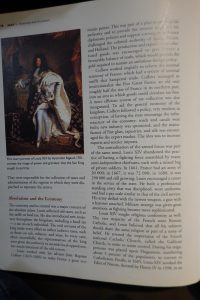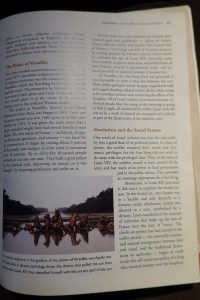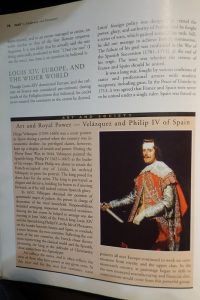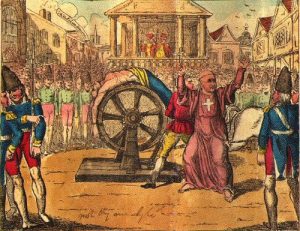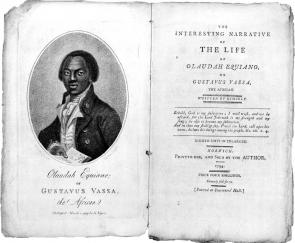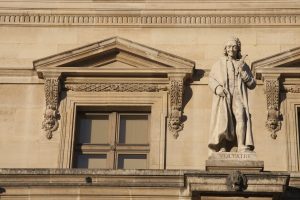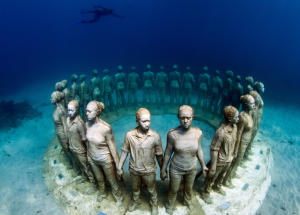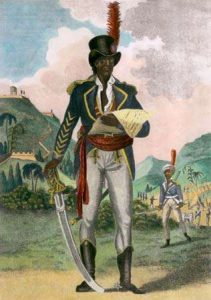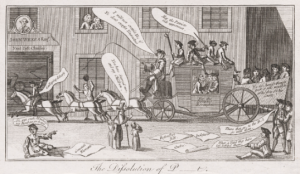Unit 2: 1650-1789
What was worth fighting for?
CHY4U_Unit2_Handouts_Quad1_2020-21 (PDF of the unit package – this has obviously been updated since then)
Please note the order of activities may be somewhat different.
1. Enlightenment
THE AGE OF REASON?
Recommended textbook pages: 83, 146-150
1: Jean Calas anecdote – from this story, try to grasp the main concepts of the Enlightenment and what enlightened philosophes thought was worth fighting for. CHY4U_Unit2_Activity1_Enlightenment_intro
2. Locke: read this for context on the social contract and types of government in Europe
Locke_handout_shortened (skipped 2023 and 2025)
CHY4U_Enlightenment_Mar_2020 (contains list of enlightened characteristics)
3. PSDs – please annotate, looking for connections to enlightened characteristics. Answer the questions below, or at least follow them as they provide clues to what is important.
CHY4U_Enlightened_PSDs_Sept_2020 (this has been updated with a section on the western world not having a monopoly on enlightenment through brief investigation of Suleiman the Magnificent and Akbar the Great. See below. )
Questions:
Political: John Locke, Two Treatises on Government; Thomas Jefferson, The Declaration of Independence
In what way did Jefferson ‘plagiarize’ Locke?
English: Olaudah Equiano, The Interesting Narrative of the Life of Olaudah Equiano, Mary Wollstonecraft, A Vindication of the Rights of Woman, 1792
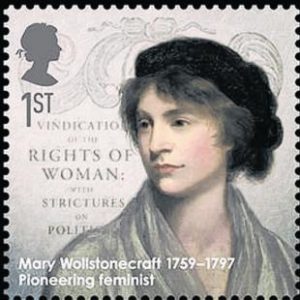
Questions:
What did Equiano hope the British government would do?
Under what condition did Wollstonecraft believe society would improve?
French: Voltaire, Superstition; Denis Diderot, Definition of Intolerance
Questions:
Diderot repeats the word ‘impious’ (blasphemous – against religion) over and over. Why is he using this religious word against the Catholic Church? Think literary styles.
What is Voltaire’s big problem with superstition?
Ruler (Enlightened Despot): Catherine the Great, Proposals for a New Law Code, 1767
Questions:
Catherine spends a lot of time arguing why absolute monarchy is suitable for Russia. How does she justify it? Is there anything enlightened in Catherine’s words/intentions?
ARGUMENT PRACTICE
Practice making arguments. Read this and see how you can make it a little bit better by making a sharper topic sentence: (I no longer spend so much time on the enlightenment philosophes; instead, I focus on the paradox of enlightenment and enslavement)
Denis Diderot was one of the main social critics of his time, particularly when it came to the abuses of the Roman Catholic Church. In an article from his multi-volume Encyclopedie called “Intolerance” Diderot portrayed the Catholic Church as hypocritical. In fact, he argued, the Church was intolerant. Diderot and other enlightened philosophes in France held a core belief in freedom of thought; as he said, “Conscience must be enlightened, not constrained.” Neither the state nor the Church should interfere with an individual’s right to his own beliefs and ideas. The problem with the Catholic Church was that it used pacifistic language such as love when in fact it used violent means to achieve its goals. According to Diderot, “Education, persuasion, and prayer, these are the only legitimate means of spreading the faith.” How hypocritical, he implied, was the Church for using violence, hatred, and sowing of division to spread Christianity. These two simple quotes portray Diderot as a hard-edged writer willing to speak his truth to power.
Here’s an interesting little tidbit on Diderot and Catherine the Great- you decide if it made her enlightened at all???
Denis Diderot and Catherine the Great of Russia came together out of necessity. Diderot’s Encyclopedie was heavily censored by the Roman Catholic Church and the French government. The pope even threatened excommunication of purchasers of it (World History, p. 449). At the time in the 1700s, France was still relatively feudal* in its social structure, though people like Diderot from the upper middle classes had a certain amount of influence in intellectual circles. Diderot was so involved in the Enlightenment that he was chased by the police, spied on, and even had to sell his works to the Empress of Russia, Catherine the Great, in order to save them from government confiscation. Catherine, seeing herself as an enlightened ruler, allowed him to retain the books and she paid him a yearly salary. He even went to visit her in Russia for six months in 1773 (Glencoe World History, p. 557). Catherine and Diderot: an likely pair but a duo who found mutual benefit in each other.
*feudal refers to the social structure of western Europe in the Middle Ages in which the wealthy lords owned the land and the poor serfs worked the land. They were stuck in a feudal relationship that, on paper, gave them some benefits, but in reality kept them from moving forward.
4. Did western Europe have a monopoly on enlightenment?
Western_World_Monopoloy_on_Enlightenment
- How do Akbar and Suleiman compare to our western European thinkers?
- Are there other characteristics of enlightenment we should now add to our list?
- How does learning about Akbar and Suleiman contribute to your understanding of the limits of western enlightenment? Does it reinforce the paradox?
- What sites should you consult? Keep COR (Civic Online Reasoning) in mind.
2. Enslavement and Resistance
Minds On: What do you think the underwater sculpture above is meant to represent? Back to your earlier definition of what the word “fight” means in “what is worth fighting for?” Now we are adding the idea of resistance. What is the difference between fighting and resisting? (please, really think about this difference).
Skills: historical perspective, inquiry questions
terminology: slave vs. enslaved person
- it is extremely important to choose terms carefully as we must fully humanize, not objectify, the people we are studying
Minds On: Slave Trade interactive map, reading by Ms. G from The Slave Ship
Students are to come up with good, curious, deep inquiry questions while viewing the interactive slave trade map. Remember, these ships were filled with humans.
CHY4U_Slave_Trade_2019 (PPT) – overview of the how the slave trade worked, especially the idea of triangular trade. Triangular trade can also be found in the textbook on page 106.

Triangular trade
Task: take notes on methods of resistance by enslaved persons from pages 108 to 111 in the textbook. Then, put them into categories (such as physical, spiritual, etc.)
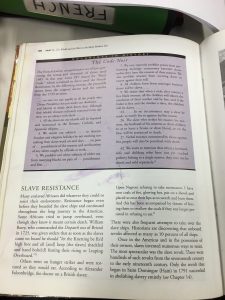

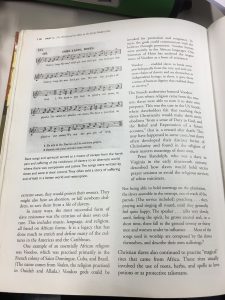
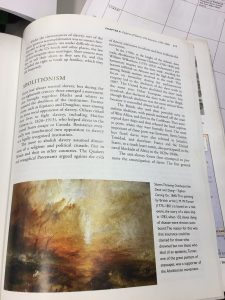
Note: Normally at this time Ms. G emphasizes how some historians used to dismiss things such as working slowly or breaking tools as evidence of the slaves’ laziness. Over time, historians have opened up their perspectives to recognize that the enslaved people were doing whatever they could to survive a brutal life, resist conditions imposed upon them and assert their humanity. Recall, historiography.
Websites for your interest:
Ted Talk (drumming banned – for your interest )
Slave Resistance at Work (Port Cities Bristol – FYI)
Code Noir
Minds On: What is the purpose of a law code? Do laws usually reinforce continuity and/or are they the leading edge of change?
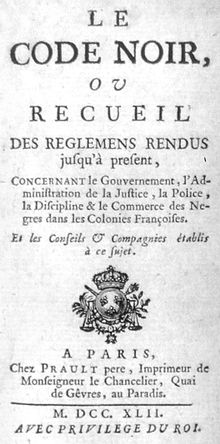
Activity:
- Fill in CHY 4U Abolitionism Code Noir chart using the PSD in the purple box on page 109 of the textbook (see photos above) – it is part of the actual Code Noir (excerpts).
- Note: the preamble (intro) says that God approves of these laws. Therefore, it’s as if God was saying to the enslaved people of the French colonies that they MUST obey the laws in the Code Noir. Also note, this code applied to the French colonies only.
2. How enlightened was Code Noir? (0-10) Explain your rating.
3. How generous did the French government think the code was? (0-10) Explain your rating.
4. Ultimately, in the unit so far, how enlightened is the enlightenment? Think about the paradox or the gap between ideas and reality. Please write a sharp, concise yet precise two-sentence answer.
Additional Questions on Code Noir:
- What do the articles in row 1 have in common? Why was religion such a big deal in this code? On the one hand, if a slaver converted his enslaved people to Christianity, what is this admitting in terms of their humanity? On the other hand, if the slaver teaches that Christianity says you’ll get into heaven if you’re obedient, how can this reinforce slavery?
- What do the articles in row 2 have in common? Why was control of family such a big deal in this code? Was there any empathy? Does that make the code enlightened at all?
- What do the articles in row 3 have in common? Why were there provisions for how enslaved people should be involved in the “justice” system? Was there actually justice for them?
Code Noir and Canada’s History:
See this article for suggestions. Ms. K, my 2025 student teacher, did a great lesson on Marie Angelique connecting to the Code Noir in Canada.
Legacy of the Atlantic Slavery Trade:
- see this article from The Guardian newspaper about its founder’s link to the slave trade.
- Also, many parts of the United States are debating and discussing reparations (repayments) for slavery.
- See this article from PBS about California’s debate (March 2023).
St. Domingue / Haiti and the Haitian Revolutions
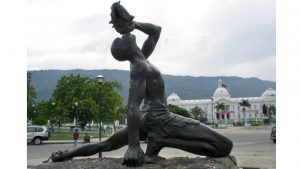
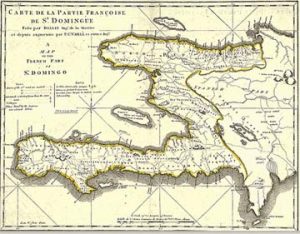
Recall, the Code Noir would have been the document that governed the lives of enslaved people in the French Caribbean colony of St. Domingue.
To understand the Haitian Revolutions (yes, more than one revolution) context please read the two documents below and answer these questions on BIG ideas:
CHY4U Social Hierarchy in StDomingue,
- where do you expect the major class conflicts to be?
- which class do you think would have started the rebellion?
Haiti_Slave_Revolution_that_Defeated_3_Empires
- why did three empires try to so hard to defeat St. Domingue/Haiti?
- why were the Haitians able to prevail?
In 2025, Ms. K, my excellent student teacher, did a great lesson on the Haitian Constitution.
Then, to get more details, read about Toussaint L’Ouverture and the rebellions in St. Domingue/Haiti (textbook pages 195-197). Note that the origins of the first revolution (starting in 1791) are quite complicated and resulted in the freeing of the enslaved peoples. The second one (ending in 1804) was the fight for independence from France.
Visit Haitian Revolution (Black Past) or The Haitian Revolution (PBS – Africans in America) if you want short overviews of the Haitian Revolutions. There is a Crash Course History video (12 minutes) as well. In it there is some reference to the French Revolution (which we haven’t learned about yet) but you should be able to get the big picture without this fore-knowledge.
3. Innovation and Origins of Industrialization
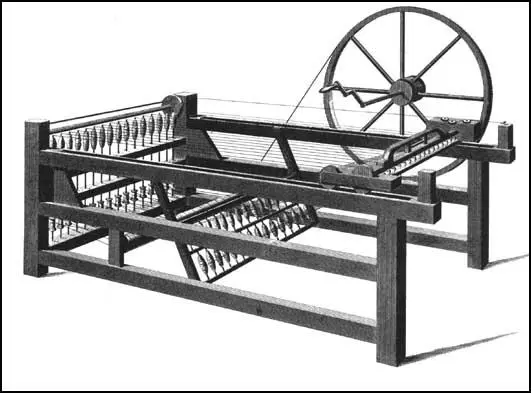
Rana Plaza was full of garment manufacturing workshops producing clothing for export to the western market and the building was obviously not safe for it. That’s what happens when companies want to make profit above all and skilled work is displaced by unskilled work and lower pay. https://cleanclothes.org/safety/ranaplaza
Minds On: How is society affected by the pace of technological change? Think about our own times: do you think we live in a time of fast-paced technological change? If so, what influence does it have on people’s lives, work, the economy, etc.? E.g., AI.
Skill: Progress and decline – the sometimes inverse relationship between those who progress and those who decline. Note that progress and decline are aspects of continuity and change.
Introduction to Industrialization:
Industrialization began in Britain in the late 1700s. It began there, rather than elsewhere, for various reasons which are somewhat outside the scope of this activity. However, what’s crucial to know is that many people invested money in new technologies that would eventually power factories to produce a lot more goods, especially cotton textiles, than before. These new technologies pushed for more efficiency/productivity. The demand for goods was high because the population in Britain was growing quickly.
Before the industrial revolution British society was largely rural and the economy was based on agriculture. Power came from wind, water, animals and humans. Some farming families also worked in what was called ‘cottage industries’, meaning they engaged in a small trade at home to supplement their farm income. For instance, they might spin wool from their sheep into yarn. A middle man would help them get the yarn to market or to a producer who’d turn it into something like clothes or blankets. But work was at home and followed the regular schedule of daily life on a farm.
Change came … During the industrial revolution urban areas grew faster as people moved to live nearby their sources of employment – the factories. The sources of power eventually became coal and steam. Coal powered factories and mills where large numbers of workers gathered under one roof were new developments. Workers were now paid a wage, usually per day or week.
The woolen industry had been in existence for a long time in Britain. However, cotton was becoming increasingly popular. Britain did not, of course, grow cotton – it grows in a warmer climate. But some of Britain’s colonies (especially India) and trading partners (such as the US southern states) did grow cotton where it was often nurtured by enslaved people. Thus one cannot separate the topics of colonization, slavery and industrialization. This will become very apparent as you make your way through the chart in the unit 2 handouts. So will the fact that certain types of workers benefited more than others. The world was changing and people’s lives were changing significantly.
Recently, in this topic, there has been much more emphasis on the connections between colonization, industrialization, and slavery. I would love to add more on environmental history; we’ll see.
Tasks:
- Read Early Inventions of Industrialization first. It gives a lot of important background. Early_Industrialization
2. Fill in the chart: Early Industrialization Activity – who was helped and who was hurt by each innovation? The possible answers are indicated for you at the top of the activity. If you don’t have your paper booklet, you can find a PDF version of it at the top of the unit 2 page.
Progress vocabulary: benefit, evolve, develop, advance, improve, innovate, change…
Decline vocabulary: regress, recess, downfall, end, collapse, slide, devolve, suffer …
3. There is a list of websites at the bottom of the document (copied below). They contain images related to early industrialization. Please visit some of the sites. If you have any uncertainties about the topic of early industrialization, the third document (oup) gives a fabulous overview of EVERYTHING. *It is not necessary to do this – just for your interest.
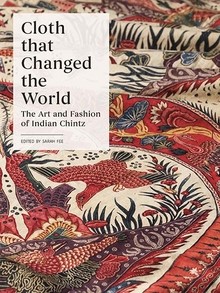
Explore some of the sites of early industrialization in England:
- http://www.derbyshireuk.net/cromford.html
- https://www.visitpeakdistrict.com/things-to-do/attractions/industrial-heritage
- https://www.oup.com.au/__data/assets/pdf_file/0017/58031/Oxford-Big-Ideas-Geography-History-9-ch5-Industrial-revolution.pdf (very thorough overview of industrialization)
- http://whc.unesco.org/en/list/371 (world’s first iron bridge)
- http://www.channel4.com/programmes/walking-through-history/on-demand/54892-002 (Tony Robinson’s Walking Through History – Derwent Valley)
4. Consequences of Exploration and Colonization – 7 Years War in Asia and North America (big changes in 2023 and 2025 – each of my two fantastic then student teachers introduced great materials on the fur trade, HBC, and relations with Indigenous people)
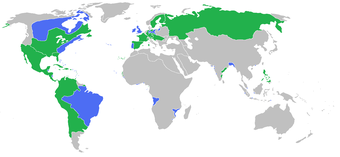
Skills: HTC – causes and consequences (intended and unintended, direct, indirect, long-term, medium-term, short-term), historical perspectives
key terms:
- mercantilism (the economic policy in which countries seek to export rather than import, protect their own markets and industries, and make profit from their colonies)
- think of it like a pie: at the time, people believed there was a limited supply of wealth. Each country had its own slice of the pie. The only way to increase the size of its slice of pie was to get it from another country, often through war
- global conflict
- thus, it should make sense that what began as a minor war in Europe (for reasons that are not even very important to us) became a global conflict about getting more pie for each country (empire)!!! These various conflicts lasted from 1756-1763.
Activity:
Annotate PSDs 1 to 7 indicating cause or consequence (or both) and what kind: intended or unintended, direct or indirect, long-term, medium-term or short-term.
I’ve included some questions to help make sure you understand each document. Feel free to email me if you have questions about particular documents. (In 2025, students only had to read about the Battle of Plassey and Proclamation of 1763).
CHY4U_Unit2_Seven_Years_War_Timeline (fyi)
Seven_Years_War_psds (2022-23 – this was shortened and Indigenous content was added – Thanadelthur, origins of the Hudson Bay Company – see this link)
1 The state of the English colonies, 1755 from the Maryland Gazette, originally published in London’s Gentlemen’s Magazine (not done 2023 and 2025)
Remember, this is pre-American Revolution. Virginia is one of the 13 American colonies controlled by Britain.
What are the advantages of Virginia in terms of agriculture, source of labour, government, education?
Who envies how awesome Virginia is? How does this relate to slices of the pie?
Cause or consequence of Seven Years War?
2 Painting: British victory at Plassey in Bengal, on June 23rd, 1757
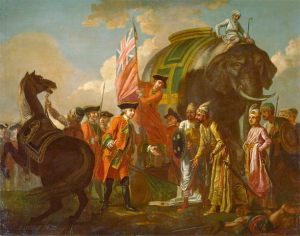
Note: Bengal was an Indian state. The British East India Company was established to increase trade between Britain and India.
Who fought whom in this 1757 battle?
How did the role of the British East India Company expand beyond trade after this battle?
Cause or consequence of Seven Years War?
3 The Battle of Quebec, 1759 (not done in 2023 and 2025)
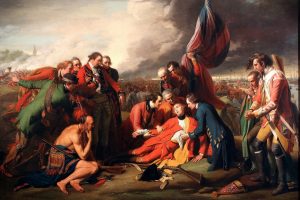
Recall your Canadian history lessons from junior high: The French came to Quebec first. Then, as the British increased their power and territory in North America they wanted Quebec, too. Eventually, the French lost other territory in North America, too. Also note that the painting was made years after the event.
Even though Wolfe (the British General) dies, how is he portrayed in the painting?
Whose slices of pie increase/decrease as a result of the Battle of Quebec?
Cause or consequence of Seven Years War?
4 Minavavana, a Chippewa chief, addressing trader Alexander Henry, as recorded by Henry, 1761 (not done 2023 and 2025)
Note: Chippewa were one of many different indigenous peoples in North America in the 1700s. Indigenous peoples had diverse relationships with American colonists and the British and French in North America.
How many years before this letter had the English conquered the French?
In the beginning of the letter Minavavana suggests that Chippewa have been allies of _______________.
How does Minavavana suggest that, normally, good relations can be established after conflict?
Why did he make an exception this time?
Why would it be important for both indigenous people and the British or French to have each other as allies in North America?
Cause or consequence of Seven Years War?
5 The Attack of Manilla, October 1762 (not done in 2025)
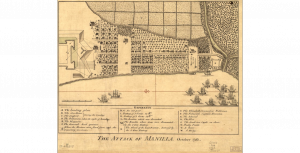
Note: Philippines was a Spanish colony. Spain was friendly with France, not Britain, at this time.
How did Philippines go back and forth to different ‘possessors’? How does this reflect slices of the pie?
What was the key factor in Britain’s success in this sub-battle of the Seven Years’ War?
Cause or consequence of Seven Years War?
6 Royal Proclamation of 1763

Note: the British took control of French territorial possessions following the Battle of Quebec (1759). These territories were not just in Quebec, but also included part of the now-US, including the Ohio River Valley. In addition, recall that at the time of this proclamation (law), the British controlled the American colonies. Through this law the British hoped to improve relations between American colonists and indigenous people west of the Mississippi River. So they created a line, the proclamation line. *
Lands west of the proclamation line were reserved for whom?
Who is forbidden to settle there or make any other use of the western lands?
Why would some American colonists be offended by this new British rule?
Why would the British feel this was a fair law?
How does this Proclamation relate to slices of the pie?
Cause or consequence of Seven Years War?
The Royal Proclamation has incredible significance for Indigenous peoples in Canada and the United States to this day. However, there are differing perspectives on this topic.
http://education.historicacanada.ca/files/31/Treaties_English.pdf
http://indigenousfoundations.arts.ubc.ca/royal_proclamation_1763/
7 The Quebec Act, 1774 (not done 2023 and 2025)
Note: the Seven Years War, known as the French and Indian War in the American colonies, was already over (1763) by the time of the Quebec Act (1774). Also, it’s important to remember that Britain was a Protestant country whereas Quebec had been Catholic. Most, not all, American colonists were also Protestant.
What did this act grant to Catholics in Quebec?
Why would the Protestant British want to do this?
Which part of the act particularly worried American colonists? Why?
How does the cartoon demonstrate this feeling?
Cause or consequence of Seven Years War?
5. Timeline with Attitude Assignment –
see tips page
6. Cultural Exchanges (New title: French Absolutism) – I haven’t done this topic for many years. It’s too bad because I had wanted to have more emphasis on Russian history in 2025 but didn’t get to it)
Absolutism: think back to what we learned about absolute monarchy at the very beginning of this unit. It was NOT the kind of government John Locke wanted because there were no limits on the monarch. Also note that Catherine the Great was an absolute monarch.
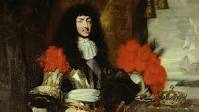
Louis XIV will serve as our model of an absolute monarch. Characteristics of absolutism include:
centralization (replaces decentralized feudalism)uniformity and fixed rules of behaviourstandardizationdevelopment of the statecontrol of power in the hands of the monarch/emperoroften based on the theory of divine right (the monarch is given the right to rule by God, NOT the social contract)often goes back to the Roman Empire as a model of stability
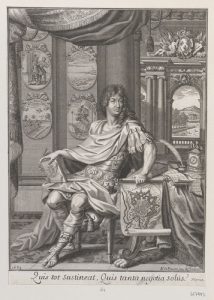
Information about the ways Louis used absolutism in France to make the country more centralized can be found in the textbook from pages 75-78 under these headings:
Take notes for each heading.
intendants (civil servants)economyarmed forcesreligionVersailles (see this video as well, only until 3:20)social system (role of nobles and others) * most important

